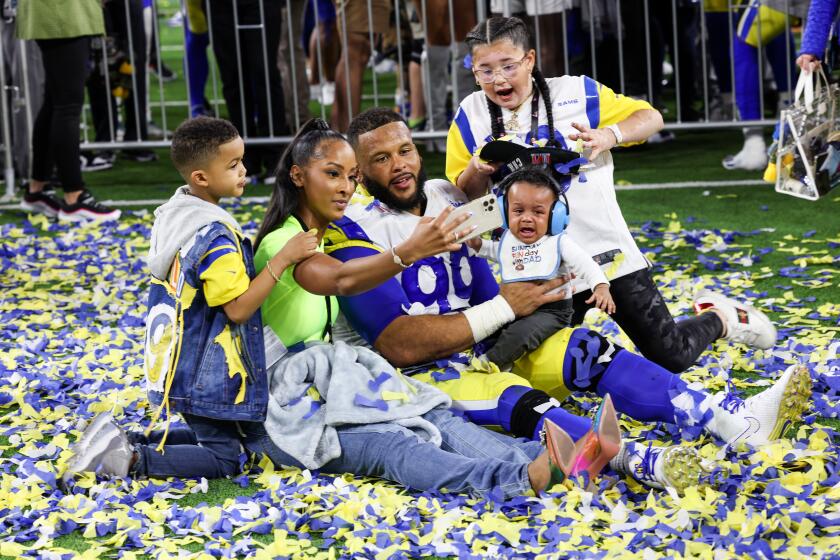Pro Football / Bob Oates : Some Additional Statistics Give a Clearer Picture of the Playoffs
The National Football League for many years has evaluated offense and defense statistically on just two factors, yards gained and allowed by each team.
Many football people have noted, however, that as a rating system, the NFL’s is remarkably incomplete.
It fails to incorporate a pair of more important factors, points scored and allowed.
Is there a remedy? There is.
In the accompanying charts:
--NFL teams have been judged offensively and defensively on 1986 performance in three areas--points scored, yards rushing, and yards passing.
--To help simplify a complex undertaking, each category has been given the same weight.
--Because there are 28 teams in the league, a top grade of 28 has been assigned to the leader in each category. The low grade in each is 1.
--Thus, if a team finished first in the NFL in most points scored as well as most yards gained rushing and passing, it would receive grades of 28 in each of the three categories.
--These would add up to 84 total rating points. And in percentage terms, 84 can be translated to 1.000. That would be the offensive rating for any team finishing No. 1 in points scored, No. 1 in yards rushing, and No. 1 in yards passing.
The chart--structured with the assistance of Seymour Siwoff, president of the Elias Sports Bureau of New York--identifies the Cincinnati Bengals, San Francisco 49ers and Minnesota Vikings as the NFL’s 1-2-3 offensive teams of 1986.
The Bengals finished third in points scored, second in yards rushing, and third in yards passing, thus earning 26, 27 and 26 rating points, respectively, or a total of 79 and a rating of .940.
The Chicago Bears and New York Giants were 1-2 defensively. The Rams and San Francisco 49ers tied for third.
The Giants are a Super Bowl favorite this year largely because of the achievements of their defensive team, which is led by All-Pro linebacker Lawrence Taylor.
Their offensive team is perceived to be much weaker. In the NFL’s measuring system, the 1986 Giants rank only 10th offensively.
But NFL statistics only include yardage. When points scored are also considered--as in these charts--the Giants are the NFL’s fifth-best offensive team today.
That provides a better picture of a title favorite.
Similarly:
--The Raiders are third defensively on the NFL’s 1986 chart. But if points allowed are considered, the Raiders are 10th. This gives a clearer picture of a defensive team that slumped at the end of the season.
--The Rams are officially fifth in the NFL’s defensive ratings. But when points are factored in, the Rams improve defensively to third, where they’re tied with the 49ers.
--Most glaringly, the NFL lists the St. Louis Cardinals as the league’s fourth-best defensive team. Throw in points allowed, though, and they’re 19th.
Statistics don’t win or lose, but sometimes they explain.
The NFC emerges with the league’s seven top-rated defensive teams: the Bears, Giants, Rams, 49ers, Falcons, Vikings and Saints.
The only others in the defensive top 10 are all from the AFC West: the Broncos, Chiefs and Raiders.
There’s a valid reason why Dan Marino missed the playoffs. The Dolphins are the NFL’s 27th-best team defensively with a rating of .143, which is 833 points behind the Bears.
For the second straight winter, the 49ers will be opening their playoff season in New Jersey Sunday against the Giants, who won a year ago, 17-3.
But Coach Bill Walsh is taking a different team east this week. Injuries kept the 49ers from competing there last winter, when, had they been playing in a mid-November game, Walsh would have benched and rested his entire backfield.
Joe Montana, Wendell Tyler and Roger Craig, among others, were hurt and only participated because it was a no-tomorrow game.
Medically, how much better are the 49ers this week?
“We’re a good 30% better,” Walsh said.
That could be enough.
The 49ers, Giants and Bears are perhaps the NFL’s teams of the future as well as the present.
Last year, the Bears became the youngest to win a Super Bowl.
This year, the 49ers and Giants have worked more rookies into their lineups than possibly any two other franchises.
Said Giant General Manager George Young: “The (six) defensive rookies we drafted first last year are all contributors.”
Among them are cornerback Mark Collins, a frequent starter from Cal State Fullerton, and linebacker Thomas (Pepper) Johnson.
Didn’t the Giants have enough linebackers?
“Who ever has enough linebackers?” Giant Coach Bill Parcells asked.
The 49ers have started no fewer than six rookies this season in one or another of their many situation lineups--cornerbacks Tim McKyer and Don Griffin, linebacker Charles Haley, defensive lineman Larry Roberts, fullback Tom Rathman and third wide receiver Derrick Crawford.
“You’ve got to keep them (rookies) coming,” Walsh said.
The Rams didn’t get any breaks Sunday. They are out of the playoffs in part because Washington played smoother football but mainly because they have yet to get their first good break in that game.
The thing that best explains the entire afternoon was the penalty call against cornerback Ram LeRoy Irvin. Irvin made a perfect defensive play--and got flagged for interference.
It was a flagrantly bad call that he didn’t protest vigorously enough. The official who gave him the extra 15 yards will be ashamed of himself when he sees the tape.
The Rams’ 1986 playoff play to remember is quarterback Jim Everett’s touchdown throw. He began with a scramble and ended with a running pass that hit the target squarely and on time. This was the one chance the Rams gave him Sunday, and he made the most of it.
Everett’s one bad play was the sack he took in the third quarter, leaving the Rams in poor field position at a critical time. Well-coordinated quarterbacks who are also well-drilled throw the ball away in that kind of crisis.
The interceptions that Everett dispatched later shouldn’t count against him. You don’t count interceptions when the quarterback of a losing team is trying to make something happen.
Ironically, the season ended the same way for both L.A. area teams--with fumbles by the best players they have, Eric Dickerson, who lost the ball in Washington, and Marcus Allen, who lost it to the Eagles.
But as Wendell Tyler always said, reporters and coaches make too much of fumbles.
In Anaheim this week, it’s got to be clear that trading the fumble-prone Tyler didn’t solve all their problems.
After Ram Coach John Robinson had stood around in the cold for five minutes in Washington Sunday, waiting on the instant-replay officials, he said: “That was a disgrace.”
That was an understatement.
The replay people still don’t understand what they were hired to do. The NFL asked them simply to cancel the big obvious blunder--the officiating error that every football fan sees vividly the first time around, or, at most, the second time.
If it’s close--if it isn’t obvious--forget it. Those were the NFL’s instructions. Can’t these people read?
The league’s instant-replay system should be reckoned for what it is, a necessary evil. If one glaringly bad call is reversed sometime next month, the whole controversial camera year will have been worthwhile.
But can’t the replay crews wait for something glaring? Are they trying to destroy a system that the NFL will need very badly again next season? The league’s frustrated owners are on the point of voting it out, and that’s a pity.
Pat Ryan’s fourth-down run for 24 yards on a quarterback draw gave the Jets the momentum to beat Kansas City Sunday.
“We never got over it,” said Kansas City Coach John Mackovic, who produced a playoff team this year out of some pretty thin material.
One doesn’t, however, expect a quarterback to run a contending team into the Super Bowl. Only a passing quarterback can get you there. And in Sunday’s game, the Jets benched their best passer, Ken O’Brien, whose confidence had been shot in a five-game losing streak.
And, of course, it’s still shot, meaning that the Jets--who should have been able to beat the Chiefs with any quarterback--may have won a skirmish but lost the war.
NFL OFFENSE
Ranking Most Pts Most Yds Most Yds Rating Offense Team Scored Rushing Passing Pts Rating 1 Cincinnati (A) 26 27 26 (79) .940 2 San Francisco (N) 22 19 27 (68) .809 3 Minnesota (N) 25 13 24 (62) .738 4 Miami (A) 28 4 28 (60) .714 5 N.Y.Giants (N) 21 23 12 (56) .666 6 Washington (N) 20 12 23 (55) .654 7 Seattle (A) 19 24 11 (54) .642 8 New England (A) 27 1 25 (53) .631 9 Chicago (N) 16 28 9 (53) .631 10 Cleveland (A) 24 7 21 (52) .619 11 Denver (A) 23 9 19 (51) .607 12 Dallas (N) 15 18 17 (50) .595 13 N.Y.Jets (A) 18 11 20 (49) .583 14 Raiders (A) 13 16 18 (47) .559 15 San Diego (A) 14 5 22 (41) .488 16 Atlanta (N) 8 26 4 (38) .452 17 Rams (N) 12 25 1 (38) .452 18 Pittsburgh (A) 11 22 5 (38) .452 19 New Orleans (N) 10 21 6 (37) .440 20 Houston (A) 6 10 16 (32) .381 21 Buffalo (A) 9 8 14 (31) .369 22 Detroit (N) 7 14 10 (31) .369 23 Philadelphia (N) 5 20 3 (28) .333 24 Kansas City (A) 17 2 8 (27) .321 25 Green Bay (N) 4 6 15 (25) .298 26 St.Louis (N) 1 15 7 (23) .274 27 Tampa Bay (N) 3 17 2 (22) .262 28 Indianapolis (A) 2 3 13 (18) .214
KEY: Teams scoring the most points during the 16-game regular season--or gaining the most yards rushing or passing--are assigned the most rating points. The best possible rating would be 28-28-28 (84). The worst would be 111 (3).
NOTE: At right, each team’s total rating points are translated to a percentage based on a top possible rating percentage of 1.000.
NFL DEFENSE
Ranking Few Pts Few Yds Few Yds Rating Defense Team Allowed Rushing Passing Pts Rating 1 Chicago (N) c8 27 27 (82) .976 2 N.Y.Giants (N) 27 28 10 (65) .774 3 Rams (N) 25 21 18 (64) .762 4 San Francisco (N) 26 26 12 (64) .762 5 Atlanta (N) 23 13 22 (58) .690 6 Minnesota (N) 24 16 16 (56) .667 7 New Orleans (N) 22 25 8 (55) .655 8 Denver (A) 16 24 13 (53) .631 9 Kansas City (A) 15 18 17 (50) .595 10 Raiders (A) 10 19 20 (49) .583 11 New England (A) 19 5 23 (47) .559 12 Seattle (A) 21 17 6 (44) .524 13 Washington (N) 20 15 9 (44) .524 14 Cleveland (A) 18 11 14 (43) .512 15 Dallas (N) 11 6 26 (43) .512 16 Houston (A) 13 9 21 (43) .512 17 Detroit (N) 14 3 25 (42) .500 18 Philadelphia (N) 17 10 15 (42) .500 19 St.Louis (N) 8 4 28 (40) .476 20 Pittsburgh (A) 12 14 11 (37) .440 21 Green Bay (N) 2 8 24 (34) .405 22 Cincinnati (A) 6 7 19 (32) .381 23 Buffalo (A) 9 20 2 (31) .369 24 N.Y.Jets (A) 7 23 1 (31) .369 25 San Diego (A) 5 22 4 (31) .369 26 Indianapolis (A) 4 12 3 (19) .226 27 Miami (A) 3 2 7 (12) .143 28 Tampa Bay (N) 1 1 5 (7) .083
KEY: Teams allowing the fewest points during the 16-game regular season--or allowing the fewest yards rushing or passing--are assigned the most rating points. The best possible defensive rating would be 28-28-28 (84). The worst would be 111 (3).
NOTE: At right, each team’s total defensive rating points are translated to a percentage based on a top possible rating of 1.000.
More to Read
Go beyond the scoreboard
Get the latest on L.A.'s teams in the daily Sports Report newsletter.
You may occasionally receive promotional content from the Los Angeles Times.










